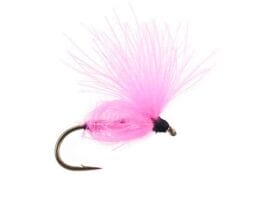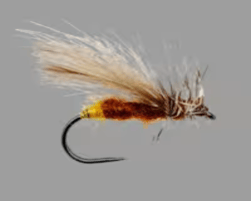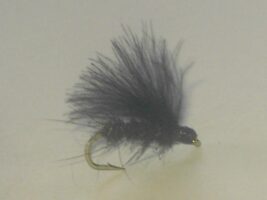Description
Product Overview and Heritage?The CDC Arpo pink fly represents a specialized pattern that combines the exceptional floating properties of CDC (Cul de Canard) feathers with a distinctive pink coloration. This pattern has become particularly effective for technical dry fly fishing situations, especially during specific mayfly hatches. The design emphasizes delicacy and natural presentation, making it a favorite among anglers targeting selective trout. The CDC Arpo pink fly has proven to attract fish in various conditions, ensuring successful outings for anglers.
Design Features and Materials?Hook Characteristics:
- Premium dry fly hooks
- Available sizes: 16-22
- Light wire construction
- Utilizing the CDC Arpo pink fly in your fly box can enhance your chances of catching more fish.
- Standard gap design
- Chemically sharpened points
- Bronze finish
- Optimal hook strength
- Enhanced penetration design
- Perfect size-to-weight ratio
- Freshwater durability
Material Components:
- CDC feathers
- Pink dubbing
- Quality thread base
- Enhanced durability
- Natural materials
- Color-fast characteristics
- Movement enhancement
- Natural appearance
- Balanced design
- Slim profile
Pattern Variations?The pattern includes:
- Standard version
- Extended body versions
- Size adaptations
- CDC density options
- Dubbing variations
- Wing positions
- Natural colors
- Flash variations
- Mixed materials
- Custom modifications
Fishing Applications and Techniques?Presentation Methods:
- Dead drift
- Downstream drift
- Multiple angles
- Drag-free float
- Pattern placement
- The CDC Arpo pink fly is also effective when used in tandem with other flies to create dynamic presentations.
- Current fishing
- Surface targeting
- Cross-current drifts
- Action variation
- Traditional methods
Specialized Applications:
- Anglers often report success using the CDC Arpo pink fly during challenging fishing conditions.
- Mayfly hatches
- Spinner falls
- Technical water
- Clear conditions
- Low light periods
- Evening fishing
- Search pattern
- Active fish
- High-pressure situations
- Selective trout
Seasonal Effectiveness?Spring Performance:
- Experienced anglers recommend the CDC Arpo pink fly for spring fishing trips to improve catch rates.
- Early season success
- Mixed techniques
- Weather changes
- Pattern selection
- Temperature increases
- Fish movement
- Feeding windows
- Natural cycles
- Light conditions
- Hatch matching
Summer Strategy:
- Evening fishing
- Morning/evening peaks
- Temperature adaptation
- Feeding patterns
- Oxygen levels
- Light penetration
- Fish behavior
- Water conditions
- Current seams
- Structure targeting
Fall Applications:
- Late-season hatches
- Cooling waters
- Changed light conditions
- Transitional periods
- Selective takes
- Pattern visibility
- Fish location
- Temperature drops
- Migration patterns
- Feeding windows
Habitat and Water Types?Water Applications:
- The versatility of the CDC Arpo pink fly allows it to perform well in various water types.
- Rivers and streams
- Spring creeks
- Tailwaters
- Clear water
- Smooth surfaces
- Structure areas
- Current seams
- Flat water
- Holding water
- Feeding lanes
Specialized Environments:
- Various waters
- Technical streams
- Different depths
- Complex currents
- Bank edges
- Multiple depths
- Pool heads
- Current breaks
- Slow sections
- Glassy water
Target Species and Behavior?Primary Species:
- Using the CDC Arpo pink fly can yield fantastic results for targeting specific species.
- Brown Trout
- Rainbow Trout
- Brook Trout
- Multiple Species
- Selective Feeders
- Surface Feeders
- Technical Fish
- Trophy Fish
Behavioral Patterns:
- Active feeding
- Selective takes
- Pattern recognition
- Natural behavior
- Opportunistic strikes
- Selective periods
- Strike triggers
- Visual stimulation
- Surface inspection
- Competitive behavior
Rigging Recommendations?Leader Setup:
- 9-12 foot leaders
- 6X-7X tippet
- Tapered leaders
- Fluorocarbon options
- Loop-to-loop connections
- Proper presentation
- Adequate stiffness
- Knot strength
- Breaking strain
- Abrasion resistance
Presentation Options:
- Single fly
- Dry-dropper rigs
- Traditional methods
- Modern techniques
- Line matching
- Leader design
- Tippet selection
- Float control
- Drift adjustment
- Action variation
Professional Applications?Guide Usage:
- Client-friendly pattern
- Proven success rates
- Consistent performance
- Easy presentation
- Multiple techniques
- Teaching tool
- Confidence pattern
- Versatile applications
- Durability
- Hook-up ratio
Tournament Usage:
- Competition proven
- Technical water success
- Pressure adaptation
- Quick-change capability
- Consistent performance
- Pattern rotation
- Size variation
- Color selection
- Presentation options
- Result tracking
Advanced Technical Applications?The pattern excels in specific technical situations that require precise presentation and natural drift. These patterns perform exceptionally well in the following scenarios:
- Mayfly hatches
- Spinner falls
- Areas with active fish
- Complex current seams
- Smooth water surfaces
Pattern effectiveness can be enhanced through specialized presentation techniques:
- Variable drift speeds
- Multiple presentation angles
- Micro-adjustments to drift
- Strategic mending for optimal float
- Counter-current presentation in complex flows
Water temperature significantly impacts pattern effectiveness:
- Optimal performance in 50-70?F range
- Increased activity during warming trends
- Enhanced success during stable barometric conditions
- Peak effectiveness during hatch periods
- Adapted presentation based on conditions
Care and Maintenance?Post-Fishing Care:
- Thorough drying
- Material grooming
- Hook inspection
- Pattern maintenance
- Material preservation
- Storage preparation
- Shape inspection
- Profile verification
- Performance testing
- Movement checking
Storage Requirements:
- Dry environment
- UV protection
- Separate compartments
- Regular inspection
- Moisture prevention
- Temperature control
- Light protection
- Ventilation needs
- Box organization
- Inventory management
Environmental Considerations?Conservation Features:
- Sustainable materials
- Durable construction
- Catch-and-release friendly
- Minimal environmental impact
- Eco-conscious design
- Material selection
- Ethical considerations
- Resource protection
- Species conservation
- Environmental awareness
Material Selection:
- Responsible sourcing
- Quality components
- Mixed elements
- Ethical production
- Sustainable practices
- Environmental impact
- Material longevity
- Waste reduction
- Local materials
- Eco-conscious design







